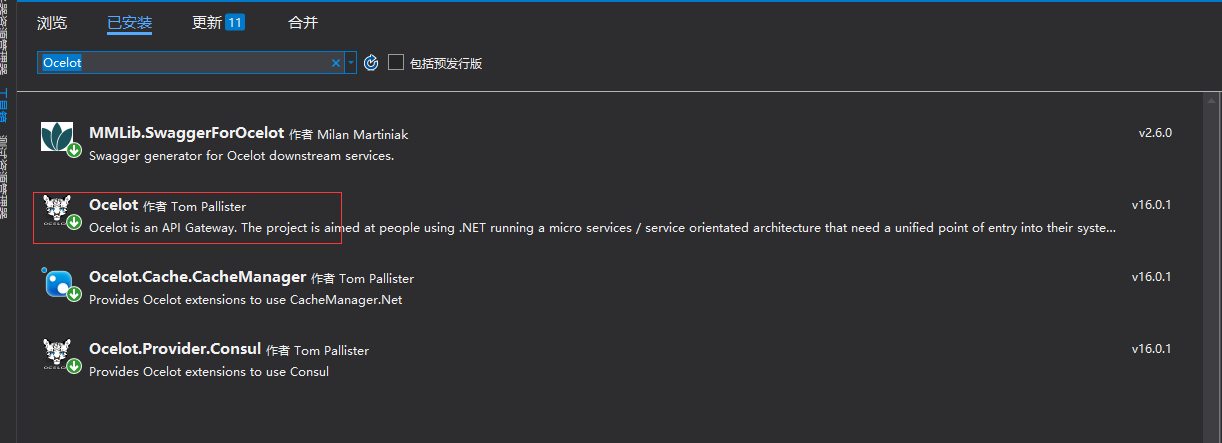Ocelot(一)-微服务网关
参考: Ocelot官方文档
Ocelot是什么:
Ocelot是.NET下最常用的轻量型微服务网关,主要是用来组织.NETCORE 的微服务为统一服务入口,业务服务实际上是不对外网开放的,统一使用微服务网关进行访问。
Ocelot设置:
创建一个netcore webapi项目 添加ocelot引用:

cache和consul 缓存和服务发现暂时不使用,可以不添加.
项目启动文件Program和StartUp代码如下:
Program.cs
using Microsoft.AspNetCore.Hosting; using Microsoft.Extensions.Configuration; using Microsoft.Extensions.Hosting; using Microsoft.Extensions.Logging; using NLog.Web; namespace GetwayService { public class Program { public static void Main(string[] args) { CreateHostBuilder(args).Build().Run(); } /// <summary> /// 使用startup初始化 /// </summary> /// <param name="args"></param> /// <returns></returns> public static IHostBuilder CreateHostBuilder(string[] args) => Host.CreateDefaultBuilder(args) .ConfigureLogging((context, loggingBuilder) => { loggingBuilder.ClearProviders(); loggingBuilder.AddDebug();//添加显示到控制台 loggingBuilder.AddConsole(); }) .ConfigureAppConfiguration((hostingContext, config) => { //config.SetBasePath(hostingContext.HostingEnvironment.ContentRootPath) // .AddJsonFile("appsettings.json", true, true); config.AddJsonFile("ocelot.json"); }) .ConfigureWebHostDefaults(webBuilder => { webBuilder.UseUrls();//配置urls webBuilder.UseStartup<Startup>(); }).UseNLog(); } }
StartUp.cs
using Microsoft.AspNetCore.Builder; using Microsoft.AspNetCore.Hosting; using Microsoft.Extensions.Configuration; using Microsoft.Extensions.DependencyInjection; using Ocelot.DependencyInjection; using Ocelot.Middleware; namespace GetwayService { public class Startup { public Startup(IConfiguration configuration) { Configuration = configuration; } public IConfiguration Configuration { get; } // This method gets called by the runtime. Use this method to add services to the container. public void ConfigureServices(IServiceCollection services) { services.AddOcelot(); services.AddControllers(); } // This method gets called by the runtime. Use this method to configure the HTTP request pipeline. public void Configure(IApplicationBuilder app, IWebHostEnvironment env) { //app.UseHttpsRedirection(); app.UseOcelot().Wait(); app.UseRouting(); app.UseAuthorization(); app.UseEndpoints(endpoints => { endpoints.MapControllers(); }); } } }
添加完后我们开始配置json文件ocelot。
1.转发设置:
非常简单不需要在业务服务商进行任何配置只需要创建一个ocelot项目,配置ocelot.json文件即可,ocelot可以配置发现服务Consul使用,也可以直接配置服务地址,不使用发现服务,这里为了入门学习暂时不使用发现服务(服务比较多的情况下推荐使用Consul).
如下所示,这里创建了一个转发服务,当访问http://localhost:8001/goods/***时,全部转发到http://localhost:7001路径下.
ocelot.json:
{ "Routes": [ { "DownstreamPathTemplate": "/{url}", //跳转到localhost:7001根路由下 "DownstreamScheme": "http", "DownstreamHostAndPorts": [ { "Host": "localhost", "Port": 7001 } ], "UpstreamPathTemplate": "/goods/{url}", //网关地址+/goods "UpstreamHttpMethod": [ "POST", "PUT", "GET","DELETE"] } ], "GlobalConfiguration": { "BaseUrl": "http://localhost:8001"//网关访问地址也是网关程序的端口地址 } }
参数解析:
ocelot主要的json参数:
GlobalConfiguration和Routes:
GlobalConfiguration网关入口设置,和业务服务无关,用于外部访问
Routes路由设置:配置网关服务接收到HTTP请求后的转发规则。
Routes参数:
Upstream***:表示网关路由
Downstream***:表示下游业务地址,也就是实际的目录网址.
DownstreamHostAndPorts:下游业务服务器,可以配置多组,使用负载均衡.
如上图所示,一个简单的转发就完成了.


